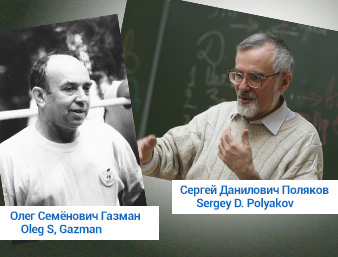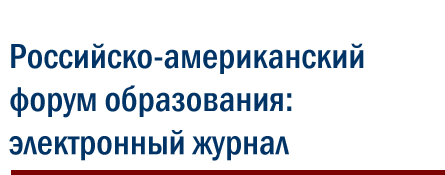

Volume: 8, Issue: 1
1/05/2016


1/05/2016
KEYWORDS: education, innovation, culture, violence, tolerance, management of innovations.
ABSTRACT: The author introduces a new approach to education considering it an innovative process. In contrast to traditional and not very efficient ways, the paper suggests another, so-called cultural approach that allows to reconsider the ratio of traditions and innovations, and the level of resistance when any innovations are being imposed. The author proposes an innovational strategy of effective educational management and defines the role of tolerance in the implementation of this strategy.
Introduction
There is a well-known statement, «Education should prepare a person not for the past but for the future». In other words, education should serve as the main innovative engine, which sets in motion the development of the society. There is hardly anyone out there who would claim that the development (including the development of education) is possible without innovations. It is also known that an innovation does not pass without resistance, even with the unanimous support. So the question arises, How to innovate and to provide maximum benefits for any development with minimal resistance?
«You already know that although the good is needed, it is a new thing … Our people will not do it without coercion », said the Russian emperor Peter the Great in the early 17th century, addressing his ministers (Edict of harvesting with scythes (11 may, 1721.). Cit. by: S. A. Nefedov P. 160). And 300 years later Russian President Boris Yeltsin in his TV address repeated almost the same words: «Unfortunately, people do not realize that changes will lead to the better, … without initiative, new outlooks, fresh approaches and ideas … a powerful breakthrough is impossible» (Yeltsin. Cit. by: M. Ormston, M. Shaw, p. 68). Not only Russian, but also international history shows that innovations are often held forcibly, without taking into account the interests of those who hold them, and even those in the name of whom they are held. «People without coercion will not accept and will not carry out measures, best designed for their own good» (George Washington. Material from Wikisource. [Electronic resource]), claimed the first American President George Washington in the 17th century. In this situation, laziness, stupidity, and resistance of the performers explain any failure.
As for education, it is almost universally regarded as violence: numerous educational theories and concepts aimed at stimulating cognitive interest, learning motivation development, etc., ignore natural children’s interest (and adults’ as well) for knowledge, self-improvement, and an aspiration for self-development. Remember the famous parable about a dog that was forcibly fed with fish oil by his owner. Each time it was happening, the dog made every effort to resist and escape. Once the dog knocked out a spoon from the hands of his master. And when an exhausted man sat down on his chair for a little rest, he noticed how his dog came up to the spoon and started licking it. The dog was not against fish oil in principle but could not come to terms with the imposed violence. Metaphorically speaking, the same happens in education: teachers tirelessly invent new ways of fighting with their students instead of helping them in their learning.
Response of culture
The appeal to culture as an objective reality not only provides an understanding of the causes of resistance, but the ways of how to optimize innovative changes as well. Culture — from the Latin cultura, from the verb colo, colere — cultivation and, later on, upbringing, education, development, and veneration. Cultural means being treated, cultivated, raised by a human being, not wild. All non-biological human manifestations (e.g., cultivated plants; the cultural layer of the Earth, with traces of human activities) are also part of this concept. Culture is a set of codes that ‘prescribe’ an individual a certain type of behavior with certain feelings and thoughts, and thereby producing a management impact on him/her. Geert Hofstede, a Dutch sociologist, proposes a set of indicators that define cultural characteristics of different peoples based on the research data received in 1960-70-ies. He claims, «culture is the collective programming of certain consciousness that distinguishes the members of one group or type from another group» (Hofstede, 2011). Culture cannot be «good» or «bad» — it is only «our» or «their» (or even «alien»). Accordingly, "cultural" doesn't necessarily mean "good" (if this is a representative of their cultures).
When I suggested that the second-year students from the Teachers’ Training University should study the problems of modern teenagers during their school field practice, my of the students were shocked with the results. As it turned out, they were not aware of real problems of those adolescents who were only five-six years younger than the students themselves. They never realized that during a short time gap there developed a new culture different from their own in terms of traditions, values, and norms. As for professional educators, in case they are thoughtful, they can easily detect that their students live in a completely different world. Without knowing this world, teachers will not be able to offer anything, which might cause their students’ interest. The result is violence.
Understanding culture from the educational point of view.
Various interpretations of ‘culture’ provide us with different educational orientations, different ‘educational medium coordinates’ or the so-called educational codes. Culture could be defined as:
As early as in Karl Marx’s works we find the assertion that the subject of activity could only externally change the surrounding space while at the same time changing oneself (Marx, p. 1-4). In other words, any activity as a practical implementation of values becomes an instrument of one’s self-change and self-development.
Tradition and innovation
A common denominator for all definitions of culture is a tradition
A tradition is:
Every innovation disturbs the tradition and causes discomfort. Most people do not find pleasure in dealing with a discomfort; therefore, emotionally they do not accept innovations. Consequently, we need to find a certain basis for the innovation’s implementation, a basis which should be grounded in the existing culture to minimize any contradictions and to show the perspectives of the development of this particular culture and its potential. This in return will help to show the positive outcomes for the people and the realization of their needs
What is the effect of forced innovations?
Every culture possesses self-preservation mechanisms. One of them is rituality. If there exists an internal opposition to the ongoing changes and an inability to actively resist them, then people just pretend while really implementing the innovation. This is particularly evident in education: while fulfilling his/her work, a teacher implements him/herself but not instructions and programs, therefore, s/he should adopt an innovation as his/her own. Culture is understood as a human activity in all its different manifestations, including multiple forms and means of human expression and self-discovery.
Only inexperienced teachers (or those tired of their work) consider students’ obedience an unquestionable virtue. Reasonable teachers know that a student who is strong-willed and who questions their knowledge is easier to teach – s/he speaks, acts, and involves in interaction!
What makes the innovation internally accepted and how to ensure it?
In fact, people want to become better, to improve their lives, and to work more efficiently. If they see that changes reflect their own desires, then it activates the internal human potential, and an innovation can produce an immeasurably greater effect than anticipated.
Educational innovations are specific in this aspect as well: teaching, social education, and development can be realized only through interaction. Therefore, in case of their internal acceptance by a teacher an innovation will potentially stimulate both – the development of a teacher and his students.
To ensure an internal adaptation of any innovation, it should ‘fit’ human relations of different types – normative/behavioral, value-oriented/ pragmatic, and meaningful /communicative. The most important is the third group of meaningful relationships, which are often unconscious/non-verbalized. They are difficult to identify and to take into account. But they could be critical as they carry the meaning for one’s own self, which translates into a serious misunderstanding of the innovation and may become an ‘iceberg’ to destroy the "Titanic of innovations.” It is better when a teacher treats the innovation as his/her own — than s/he can fully comprehend it and make it meaningful. It can "warm" the teacher up and make the process of implementing innovations more comfortable.
Emotional rejection causes a contradiction with two other groups of relations. A contradiction with an internally adopted (familiar) norm is perceived as ‘abnormal’, and thus, potentially hostile, dangerous, and the one to resist. A contradiction with the values that a person demonstrates in his/her activities is perceived as a direct confrontation.
Cultural foundation of innovations.
Innovations should be related to regulatory relations in one’s national culture, culture of socio-professional groups, traditions of the region, city, school, and family. Basically, they are moral norms. Innovations should also correspond with value relations, which means, with human ideological attitudes, announced goals, a corporate culture of the communities where an individual belongs to, and religious views. The latter’s core is spiritual values. Innovations correspond meaningful relations, which reveals itself in the communication manner, friendly relationships, dreams, needs (not even perceived), and beliefs (and superstitions). All of them are regulated by an individual moral sphere.
Management of innovations in education.
To bring any innovation from ‘top down’, it should become an innovation from ‘bottom up’. No manipulation is acceptable, because even when it is not understood as such, it will still cause an emotional rejection. It is essential to create the conditions for free initiatives of teachers and other school staff members, students and their parents, to support any perspective projects and ensure their implementation. The strategy initially seems complicated, but in fact it is more feasible.
Instead of conclusion: tolerance is the way for effective innovations.
There is an unshakeable stereotype among educators that if someone is tolerant that means he/she is a conformist, ready to allow anything and to waive any sorts of prohibitions and restrictions, including moral, ethical, or spiritual. To overcome this stereotype one should share the understanding of tolerance as having a sustainable lifestyle and an ability to be a subject of his/her own life. Tolerance means, first and foremost, the respect for another person and his/her position, although not necessarily an acceptance of this position. Anyway, tolerance presupposes independence and a non-fighting attitude towards someone’s ideas, and what is most important, a responsibility for one’s own beliefs and actions, an understanding of their relativity; in other words, accepting the fact that there never exists a situation when everybody would agree with you.
Tolerance manifests itself at three levels:
Our research shows that to regulate an adequate behavior a convention is sufficient, but if to consider going further and establish meaningful relations, then the sides need a compromise, and in order to provide any e fficient activity a consensus among people is essential.
The prime criterion of tolerant interactions is a sincere desire of the parties to build their relationships on the basis of usefulness or the so-called «rational egoism». The main problem remains – that is teachers’ disbelief in the efficiency of tolerance, their constant attempts to manipulate schoolchildren. The reaction of students to the hypocrisy of their teachers varies from students’ adherence to formal ‘rituality’ or a flashy consent, or a direct protest. The transactional analysis considers that in response to a mentoring teacher's position (similar to a parent), a student would either take a position of «a child» (manipulation of the adult from bottom-up), or a position of «a parent» (confrontation), but never a position of «an adult» (cooperation).
References
Home | Copyright © 2025, Russian-American Education Forum